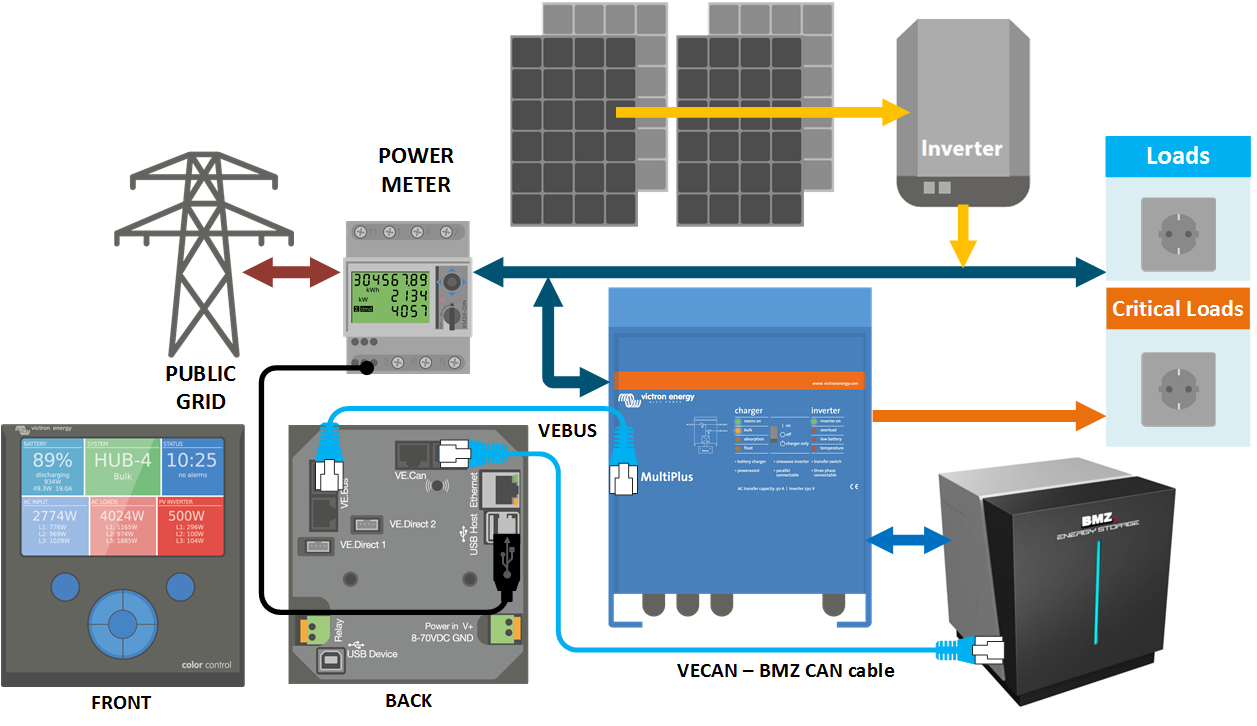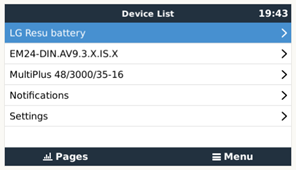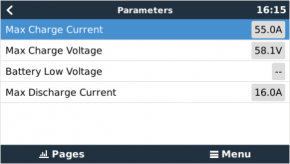This is an old revision of the document!
Table of Contents
Victron & BMZ ESS 3.0 / ESS 7.0
1. Introduction
1.1 Compatible Victron products
All 48V Multis and Quattros. And always a Color Control GX is necessary in the system, since that has the canbus port which is used for the (required!) communication between the ESS battery and the Victron system.
1.2 Notes
- Victron & BMZ integration is designed for Hub-4 (grid-parallel) systems, not for other system types. For more information about Hub4, see its manual.
- Paralleling multiple BMZ ESS batteries to expand capacity is possible. Contact BMZ for more information.
- Derating, based on the dynamic BMZ ESS charge- and discharge limits:
- Minimum CCGX version is v1.36
- When the system operates in state of charge areas where derating is necessary, typically below 20%: do not connect loads to the AC-Out of the Multi. Any power flowing from the battery to the AC-Out is not taken into account and will cause extra discharge current during discharge. And during charging the power drawn by loads connected to the AC-Out of the Multi will cause a reduced charge current.
- The derating mechanism is not very precise yet. In other words, do not expect a discharge limit of 30A to result in a precise discharge of 30A.
- Actual charge- and discharge limits are visible in the Parameters page. See screenshot below in Chapter 4.
1.3 System diagram

2. Wiring of communication cables
To use the BMZ ESS in Victron system, it is necessary to use a Color Control GX. The Color Control GX takes care of sending the necessary canbus keep-a-live message to the ESS battery. Without it, the battery will open its internal emergency relay after 10 minutes.
A special RJ-45 cable is necessary to connect the battery to the Color Control GX. Pinout:
| Function | VE.Can RJ-45 | BMZ ESS RJ-45 |
|---|---|---|
| GND | Pin 3 | Pin 2 |
| CAN-L | Pin 8 | Pin 5 |
| CAN-H | Pin 7 | Pin 4 |
Place a VE.Can terminator in the empty socket on the CCGX
3. VEConfigure settings
3.1 Charge tab
| Parameter | Setting |
|---|---|
| Battery type | Lithium |
| Charge curve | Fixed |
| Absorption voltage | 56.8 V |
| Float voltage | 56.7 V |
| Absorption time | 1 Hr |
Note: make sure to double check the float voltage after completing Assistants, and if necessary set it back to 56.7 V.
3.2 Hub-4 Assistant
Select the fourth battery type:

Then:
- Enter the battery capacity:
- BMZ ESS 3.0 - 121.5 Ah
- BMZ ESS 7.0 - 121.5 Ah
- Do not change the dynamic cut-off values, they have already been set correctly after selecting the lithium battery type.
- Same for the restart offset: do not change that.
- When required, configure the system to Stop discharging on low SOC. Minimum advised value is (
to be defined by BMZ)
4. Color Control GX Configuration
- Enable the CAN-bus BMS Service in the CCGX. Menu path: Settings → Services → CAN-bus BMS. Note that this changes the function of a VE.Can port: it is not possible to connect both VE.Can products and a BMZ battery together.
- After properly wiring and setting up, the BMZ ESS will be visible as a battery in the device list:

- The parameters option within the battery page shows the actual battery charge and discharge limits:

- Make sure to enable the Synchronize VE.Bus SOC with battery setting in the System Setup page in the CCGX: it will copy the State of Charge as reported by the BMZ ESS to the Multi or Quattro, making Hub-4 work with that SOC.
DISQUS
~~DISQUS~~
 Add this page to your book
Add this page to your book  Remove this page from your book
Remove this page from your book  Manage book (
Manage book ( Help
Help